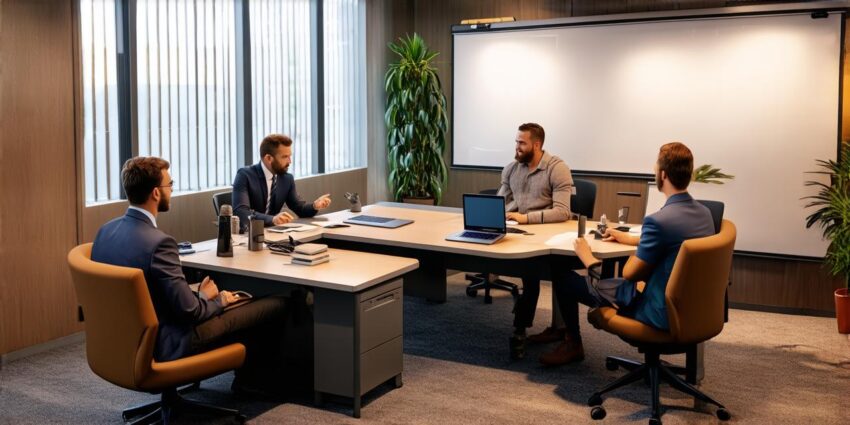
The Power of Team Discussion
Team discussion is a process that brings together individuals to discuss shared goals, challenges, and ideas in an open and collaborative environment. This type of discussion can take many forms, from formal meetings to informal brainstorming sessions. In today’s fast-paced world, team discussion has become an essential tool for fostering creativity, problem-solving, and innovation.
One of the most significant benefits of team discussion is its ability to promote effective communication among team members. By discussing ideas and challenges in real-time, team members can identify potential roadblocks and develop strategies to overcome them. This type of collaboration can lead to improved decision-making, increased productivity, and better outcomes overall.
Another benefit of team discussion is its ability to foster creativity and innovation. When team members are encouraged to share their ideas and perspectives openly, they are more likely to generate new and innovative solutions to problems. This type of brainstorming can lead to the development of new products or services, improved processes, and more efficient workflows.
Research has also shown that team discussion can have a positive impact on employee engagement and job satisfaction. When team members feel valued and heard, they are more likely to be motivated to contribute their best efforts and take pride in their work. This type of collaboration can lead to improved morale, higher retention rates, and better overall business performance.
Case Studies: Success Stories of Team Discussion
To illustrate the benefits of team discussion, let’s look at some real-life examples.
1. Google’s 20% Time
In 2002, Google introduced a policy that allowed employees to spend 20% of their time working on projects related to their passions and interests. This type of freedom led to the development of many innovative products, such as Gmail, Google Maps, and YouTube. By allowing team members to follow their interests and pursue their ideas, Google was able to tap into the power of creative thinking and problem-solving.
2. Apple’s Braintrust
In the early years of Apple, Steve Jobs would invite a small group of his closest advisors to brainstorming sessions. These “braintrust” meetings allowed Jobs to get feedback on his ideas and gain new perspectives on how to improve Apple’s products and services. By fostering open communication and collaboration among team members, Jobs was able to create some of the most iconic products in history, such as the Macintosh computer and the iPod.
랑
3. NASA’s Mars Rovers
When NASA launched its first Mars rover, Sojourner, in 1997, it faced many challenges, including communication issues and harsh terrain. To overcome these obstacles, NASA established a dedicated team discussion that included scientists, engineers, and mission control specialists. By working together to develop solutions and troubleshoot problems, the team was able to successfully navigate the rover across Mars and collect valuable data for future missions.
Best Practices for Team Discussion
To maximize the benefits of team discussion, it’s important to establish best practices that promote effective communication, collaboration, and creativity. Here are some tips:
- Establish clear goals and expectations: Before beginning any team discussion, it’s essential to define the objectives and desired outcomes. This will help team members stay focused and motivated throughout the process. It’s also important to establish clear roles and responsibilities, as well as guidelines for participation and respectful dialogue.
- Encourage active listening: Active listening is a critical component of effective communication and collaboration. To promote active listening, encourage team members to ask questions, clarify misunderstandings, and provide constructive feedback. This will help ensure that everyone is on the same page and working towards the same goals.
- Foster creativity and innovation: Encourage team members to share their ideas openly and think outside the box. To do this, create a safe and supportive environment where everyone feels free to express themselves without fear of judgment or criticism. You can also use brainstorming techniques, such as mind mapping or SWOT analysis, to help generate new ideas and solutions.
- Document outcomes and next steps: After each team discussion, it’s important to document the outcomes and next steps. This will help ensure that everyone is on the same page and working towards the same goals. It’s also a useful tool for tracking progress and identifying areas for improvement.
- Continuously improve: Finally, it’s essential to continuously improve your team discussion process. Solicit feedback from team members and make adjustments as needed. This will help ensure that your team discussion remains effective and relevant over time.
Conclusion
In conclusion, joining a dedicated team discussion can be an incredibly powerful tool for fostering collaboration, creativity, and innovation. By promoting effective communication, problem-solving, and open dialogue, team discussion can lead to improved decision-making, increased productivity, and better outcomes overall. Whether you’re at work or in your personal life, embracing the power of team discussion can help you achieve your goals and build strong connections with others.
FAQs
Here are some frequently asked questions about team discussions:
- What is the difference between a team meeting and a team discussion? A team meeting is a structured event where team members come together to discuss specific topics or tasks. A team discussion, on the other hand, is an open and collaborative process that encourages creative thinking, problem-solving, and open dialogue.
- How often should I hold team discussions? The frequency of team discussions will depend on the goals and objectives of the process. As a general rule, it’s best to hold team discussions regularly, but not so frequently that they become a distraction or lose their effectiveness.
- What are some common barriers to effective team discussion? Some common barriers to effective team discussion include lack of clear goals, ineffective communication, resistance to change, and lack of participation or engagement from team members.
- How can I encourage active listening during team discussions? To encourage active listening during team discussions, you can use techniques such as asking questions, clarifying misunderstandings, providing constructive feedback, and summarizing key points. You can also establish ground rules for respectful dialogue and create a safe and supportive environment where everyone feels free to express themselves.
Conclusion
In conclusion, joining a dedicated team discussion can be an incredibly powerful tool for fostering collaboration, creativity, and innovation. By promoting effective communication, problem-solving, and open dialogue, team discussion can lead to improved decision-making, increased productivity, and better outcomes overall. Whether you’re at work or in your personal life, embracing the power of team discussion can help you achieve your goals and build strong connections with others.
